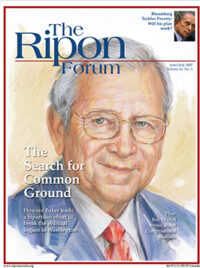
Earlier this year, Senator Joe Lieberman (I-CT) made some news when he convened a hearing of the Senate Homeland Security and Governmental Affairs Committee.
The news didn’t have to do with any bill or issue the Committee was considering. Rather, it had to do with where the members of the Committee were sitting. Tossing tradition aside, Lieberman – the Committee’s Chairman – decided to seat the Committee members together in alternating fashion, according to their party affiliation.
As a result, instead of having Republicans seated on one side of the dais and Democrats on the other, the Committee members were now seated side by side. In putting forward this unorthodox seating arrangement, Lieberman released a joint statement with the Committee’s Ranking Republican, Susan Collins (R-ME), which said:
“In the last election, the voters said they were sick of the partisanship that produces gridlock. They want us to work together and get things done. So, as a start, instead of sitting on opposite sides of the room like a house divided, we want the American people to see us sitting side by side as our Committee members work together to make our nation more secure and our government more efficient.”
The reaction to the plan ranged from the expected to the predictable. Good government types loved it, while cynics simply sneered. In searching for some sort of deeper meaning behind the plan, the Washington Post quoted an unnamed Hill staffer as saying, in reference to the Connecticut Senator’s 2006 decision to leave the Democratic Party and become an Independent, “It’s because Lieberman can’t decide what side he’s on anymore.”
This was a good soundbite, for sure. But in putting forward a plan designed to bring Republicans and Democrats closer together, Lieberman was not looking for soundbites. Rather, he was trying to encourage the members of the Committee to look beyond the cameras and focus instead on the work that was at hand. Put another way, he was asking them to forget they were divided along a dais and imagine instead they were seated together at a table.
In fact, this is the way committees used to meet. It was only in the mid-20th Century that Congress moved away from this tradition. According to Dr. Betty Koed with the United States Senate Historical Office, the change occurred with the construction of the Dirksen Senate Office Building in the 1950s. The committee rooms in Dirksen were built to accommodate television cameras. One of the accommodations was to do away with the tables committee members used and have them sit on an elevated dais instead. No doubt, this new method of seating helped to bring members closer to the viewers at home. But it also served to create a certain separation among Committee members that didn’t exist before.
In some respects, a similar thing had happened earlier in the century with the construction of new House and Senate Office Buildings. Whereas before Members would spend more time in the House and Senate chambers, they now had their own personal office to retreat to across the street. No longer would a Senator draft a bill at his desk on the Senate floor surrounded by his colleagues, only to have it debated and discussed in Committee by Committee members who were seated at a table. Now, members were free to come and go as they pleased, writing pieces of legislation in private, then having their proposals debated by members of a Committee who were perched on a dais and had a bank of television cameras staring them in the face.
One of the maxims of architectural design is that form follows function. If that is true, then perhaps the design of the House and Senate Committee rooms and office buildings on Capitol Hill has contributed to the partisan warfare that seems to have gotten worse over the last generation. The buildings are splendid – Cannon, Longworth and Rayburn on the House side; Russell, Dirksen and Hart on the Senate side. But in their own way, they have forced members of Congress apart, instead of bringing them together.
That’s why Joe Lieberman may be onto something. It’s also why his proposal to seat Republicans and Democrats side by side on his committee might produce chuckles in the short term but dividends down the road.
Billy Pitts is a former longtime staff member in the U.S. House of Representatives and current member of the Editorial Board of the Ripon Forum. Lou Zickar is the Forum’s Editor.




